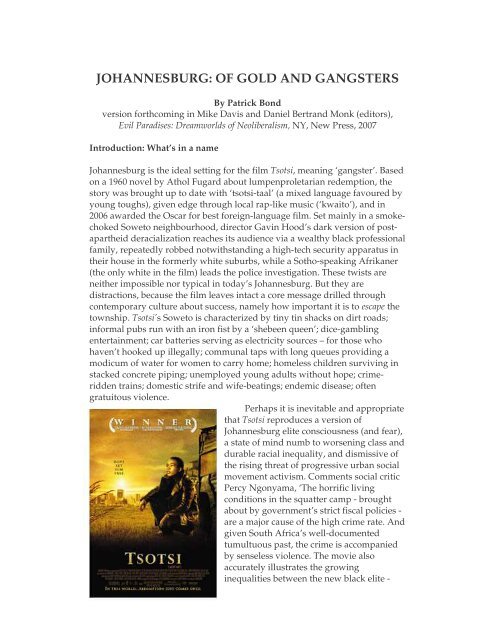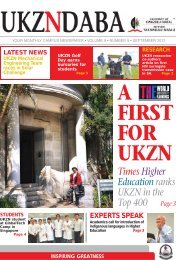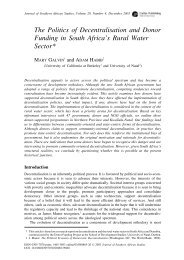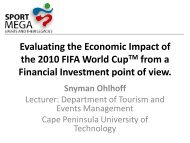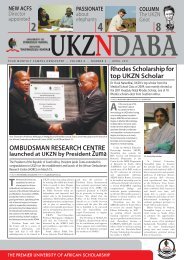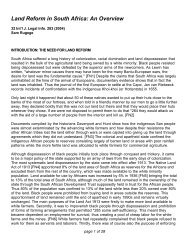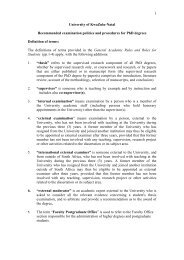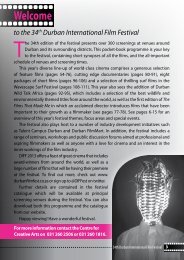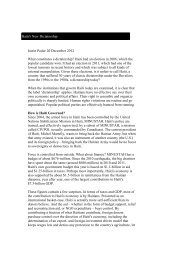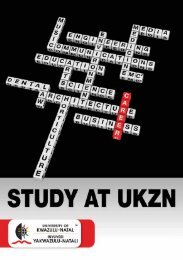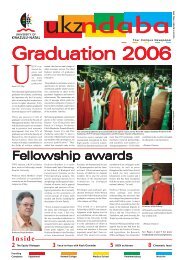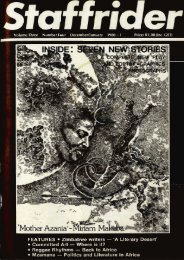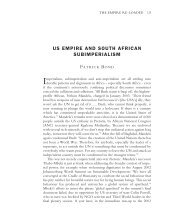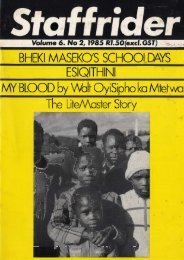johannesburg: of gold and gangsters - Centre for Civil Society ...
johannesburg: of gold and gangsters - Centre for Civil Society ...
johannesburg: of gold and gangsters - Centre for Civil Society ...
Create successful ePaper yourself
Turn your PDF publications into a flip-book with our unique Google optimized e-Paper software.
JOHANNESBURG: OF GOLD AND GANGSTERS<br />
By Patrick Bond<br />
version <strong>for</strong>thcoming in Mike Davis <strong>and</strong> Daniel Bertr<strong>and</strong> Monk (editors),<br />
Evil Paradises: Dreamworlds <strong>of</strong> Neoliberalism, NY, New Press, 2007<br />
Introduction: What’s in a name<br />
Johannesburg is the ideal setting <strong>for</strong> the film Tsotsi, meaning ‘gangster’. Based<br />
on a 1960 novel by Athol Fugard about lumpenproletarian redemption, the<br />
story was brought up to date with ‘tsotsi-taal’ (a mixed language favoured by<br />
young toughs), given edge through local rap-like music (‘kwaito’), <strong>and</strong> in<br />
2006 awarded the Oscar <strong>for</strong> best <strong>for</strong>eign-language film. Set mainly in a smokechoked<br />
Soweto neighbourhood, director Gavin Hood’s dark version <strong>of</strong> postapartheid<br />
deracialization reaches its audience via a wealthy black pr<strong>of</strong>essional<br />
family, repeatedly robbed notwithst<strong>and</strong>ing a high-tech security apparatus in<br />
their house in the <strong>for</strong>merly white suburbs, while a Sotho-speaking Afrikaner<br />
(the only white in the film) leads the police investigation. These twists are<br />
neither impossible nor typical in today’s Johannesburg. But they are<br />
distractions, because the film leaves intact a core message drilled through<br />
contemporary culture about success, namely how important it is to escape the<br />
township. Tsotsi’s Soweto is characterized by tiny tin shacks on dirt roads;<br />
in<strong>for</strong>mal pubs run with an iron fist by a ‘shebeen queen’; dice-gambling<br />
entertainment; car batteries serving as electricity sources – <strong>for</strong> those who<br />
haven’t hooked up illegally; communal taps with long queues providing a<br />
modicum <strong>of</strong> water <strong>for</strong> women to carry home; homeless children surviving in<br />
stacked concrete piping; unemployed young adults without hope; crimeridden<br />
trains; domestic strife <strong>and</strong> wife-beatings; endemic disease; <strong>of</strong>ten<br />
gratuitous violence.<br />
Perhaps it is inevitable <strong>and</strong> appropriate<br />
that Tsotsi reproduces a version <strong>of</strong><br />
Johannesburg elite consciousness (<strong>and</strong> fear),<br />
a state <strong>of</strong> mind numb to worsening class <strong>and</strong><br />
durable racial inequality, <strong>and</strong> dismissive <strong>of</strong><br />
the rising threat <strong>of</strong> progressive urban social<br />
movement activism. Comments social critic<br />
Percy Ngonyama, ‘The horrific living<br />
conditions in the squatter camp - brought<br />
about by government’s strict fiscal policies -<br />
are a major cause <strong>of</strong> the high crime rate. And<br />
given South Africa’s well-documented<br />
tumultuous past, the crime is accompanied<br />
by senseless violence. The movie also<br />
accurately illustrates the growing<br />
inequalities between the new black elite -
very out <strong>of</strong> touch with reality - in plush suburbs, who drive around in their<br />
luxurious German vehicles, <strong>and</strong> the hungry masses in the shacks who are<br />
struggling to make ends meet.’ 1<br />
Yet as Ngonyama agrees, you<br />
wouldn’t know from Tsotsi<br />
that organized popular unrest<br />
<strong>of</strong>fers just as durable a legacy <strong>of</strong><br />
apartheid’s oppression, <strong>of</strong> postapartheid’s<br />
economic alienation<br />
<strong>and</strong> <strong>of</strong> hope <strong>for</strong> resistance <strong>and</strong><br />
revolution.<br />
Johannesburg remains one<br />
<strong>of</strong> the world’s crime capitals<br />
partly because it hosts amongst<br />
the world’s most entrenched<br />
systems <strong>of</strong> urban inequality. 2 This<br />
quintessential neoliberal dystopia<br />
is a far cry from the promises <strong>of</strong> a<br />
liberation movement, the African<br />
National Congress (ANC), carried<br />
to national, provincial <strong>and</strong><br />
municipal power in mid-1990s<br />
l<strong>and</strong>slides. The ANC’s m<strong>and</strong>ates<br />
were as far-reaching as the<br />
Freedom Charter (1955), whose proto-socialism was invoked at a large rally<br />
near Soweto, or the more detailed Reconstruction <strong>and</strong> Development Programme<br />
(1994), which in part reflected the influence <strong>of</strong> trade union <strong>and</strong> left social<br />
movements, <strong>and</strong> which served as the ANC’s first electoral campaign plat<strong>for</strong>m.<br />
Those m<strong>and</strong>ates could have justified, at the very minimum, trans<strong>for</strong>ming<br />
Johannesburg, instead <strong>of</strong> amplifying its spatial, racial, gendered, ecological<br />
<strong>and</strong> class contradictions. The city’s very name, honoring Johannes Rissik,<br />
surveyor <strong>of</strong> the stolen l<strong>and</strong> where <strong>gold</strong> was discovered in 1886, is an<br />
apartheid hangover. 3 A genuine liberation movement – or even self-conscious<br />
black nationalists – would, at the least, have relabeled the city ‘iGoli’ (city <strong>of</strong><br />
<strong>gold</strong> in isi-Zulu), 4 perhaps, or ‘Soweto’, 5 or even the more hip version ‘Jozi’.<br />
Instead, in 2001, elite opinion concluded that a slightly new br<strong>and</strong>, ‘Joburg’,<br />
was ‘an opportunity to revitalize the image <strong>of</strong> the city’, whose <strong>of</strong>ficial name<br />
would go unchanged. As Mayor Amos Masondo put it, ‘The new logo seeks<br />
to galvanize citizens <strong>of</strong> Johannesburg behind a common vision <strong>of</strong> building a<br />
world class African city: young, ambitious <strong>and</strong> successful.’ 6 South Africa’s<br />
largest metropolis, responsible <strong>for</strong> 16%<br />
<strong>of</strong> the country’s economy, Johannesburg<br />
is the only African ‘world-class city’<br />
typically included in such lists. 7<br />
2
A futile quest by<br />
city fathers (no<br />
women were<br />
involved) <strong>for</strong> a<br />
neoliberal economic<br />
utopia soon merged<br />
with Gauteng<br />
Province’s inanely<br />
br<strong>and</strong>ed ‘Blue IQ’<br />
investment incentive<br />
gimmickry, favoring<br />
<strong>for</strong>eign investors <strong>and</strong><br />
local wealthy<br />
entrepreneurs at the<br />
expense <strong>of</strong> the<br />
citizenry. (The class<br />
bias was abundantly<br />
clear when in the<br />
dilapidated Newtown arts/culture district that serves as the local Left’s only<br />
semi-liberated zone, Blue IQ’s gentrification strategy threatened to displace<br />
the venerable Workers’ Library <strong>and</strong> the socialist-controlled Khanya College,<br />
until organized resistance won out in 2003.) Johannesburg’s Afrikaner-driven<br />
construction sector – the heart <strong>of</strong> the city’s growth coalition - cohered during<br />
the mid-2000s with two victories: winning key host status <strong>for</strong> the 2010 soccer<br />
World Cup (with vast stadium refurbishment costs) <strong>and</strong> constructing a $3<br />
billion ‘Gautrain’ fast service connecting the newly-renovated international<br />
airport to the new S<strong>and</strong>ton financial district <strong>and</strong> then Pretoria <strong>and</strong> central<br />
Johannesburg, although links to Soweto or any other black township were<br />
curiously omitted. 8 In any case, ticket prices will be far out <strong>of</strong> the range <strong>of</strong><br />
working-class budgets. A final crucial element <strong>of</strong> the restructured<br />
Johannesburg <strong>of</strong> the 2000s is the uneven wave <strong>of</strong> property speculation that<br />
swept the country: from 1997-2004 real estate prices in South Africa rose 200%<br />
(two <strong>and</strong> half times more rapidly than in even the bubble-ridden United<br />
States), <strong>and</strong> as a result, ‘the banks’ high level <strong>of</strong> property exposure is a source<br />
<strong>of</strong> vulnerability’, warned the International Monetary Fund in 2005. 9 Casinos<br />
<strong>and</strong> shopping malls were the main site <strong>of</strong> construction capital, at a rate in<br />
Johannesburg alone that sometimes exceeded the entire national low-income<br />
housing budget.<br />
Johannesburg st<strong>and</strong>s exposed as a city unable to break from its inherited<br />
built environment 10 , the speculative character <strong>of</strong> South African capital<br />
accumulation, or its rulers’ neoliberal mindset. As Martin Murray explains,<br />
Johannesburg is an unsettled city with its own distinctive style <strong>of</strong> get-richquick<br />
materialism, its own impatient br<strong>and</strong> <strong>of</strong> ‘instant urbanism’ <strong>and</strong> its<br />
own self-indulgent, narcissistic arrogance. This ‘course city <strong>of</strong> <strong>gold</strong>’ arose<br />
as a farflung European outpost on the marginal playing-fields <strong>of</strong> world<br />
3
capitalism. As a symbolic expression <strong>of</strong> intent, the evolving architectural<br />
vernacular <strong>of</strong> Johannesburg has always reflected the self-conscious desire<br />
<strong>of</strong> urban planners, design specialists, <strong>and</strong> corporate clients to favorably<br />
position the city in the vaunted global economy by emulating, <strong>and</strong><br />
sometimes even crassly imitating, the built environment <strong>of</strong> the European<br />
<strong>and</strong> American metropolitan core. 11<br />
Imitating other aspirant financial centers, Johannesburg’s simultaneously<br />
precarious, parasitical posture reflects the logic <strong>of</strong> neoliberal capital<br />
accumulation. Beginning in 1994, South Africa’s traditionally racist <strong>and</strong><br />
pollution-intensive companies were embraced by a grateful black elite,<br />
including vulgar politicians <strong>and</strong> state <strong>of</strong>ficials (the revolving door is notorious).<br />
To be sure, the onset <strong>of</strong> free-market economic policies based on an exportorientation<br />
fetish preceded M<strong>and</strong>ela’s ANC government by a few years. But a<br />
small clique <strong>of</strong> ‘New Guard’ ANC <strong>of</strong>ficials today work closely with the leftover<br />
‘Old Guard’ bureaucrats whose commitment to racial apartheid is conveniently<br />
<strong>for</strong>gotten but who prosper just as nicely while building class apartheid.<br />
Together, the ruling party <strong>and</strong> its new-found Afrikaner co-conspirators:<br />
• allowed vast sums <strong>of</strong> rich white people’s loot to escape through relaxing<br />
already porous exchange controls in 1995;<br />
• let the largest firms (Anglo American, DeBeers, South African Breweries,<br />
Old Mutual, Didata) relocate their financial headquarters to London from<br />
1998-2000, in the process evacuating pr<strong>of</strong>its <strong>and</strong> dividend flows <strong>for</strong>ever;<br />
• cut primary corporate tax rates from 48% in 1994 to 30% five years later –<br />
achieving a level that is fifth lowest when compared to more than two<br />
dozen OECD countries - in search <strong>of</strong> new fixed capital investment that<br />
never materialized;<br />
• watched aimlessly as business fired a fifth <strong>of</strong> all <strong>for</strong>mal-sector workers;<br />
• allowed industries like clothing, footwear <strong>and</strong> appliances to collapse under<br />
international competition; <strong>and</strong><br />
• incessantly privatized or corporatized once-<strong>for</strong>midable public assets,<br />
including Johannesburg’s municipal suppliers <strong>of</strong> water (to the Paris firm<br />
Suez) <strong>and</strong> electricity (to the US firm AES).<br />
Johannesburg top down<br />
If international capitalists <strong>and</strong> Northern<br />
Hemisphere tourists are the top priority,<br />
what do they see when they fly into the<br />
city, especially after passing through the<br />
thick brown cloud <strong>of</strong> particulates during<br />
the April-November dry season<br />
Temperature inversions <strong>and</strong> the lack <strong>of</strong><br />
rain are the natural reasons that<br />
Johannesburg’s 1500 meter high<br />
4
elevation <strong>and</strong> brisk winds still don’t provide clean air during most <strong>of</strong> autumn,<br />
winter <strong>and</strong> spring. Viewed from above, the filthy smudges <strong>of</strong> human<br />
fingerprints are everywhere to partake: concentrated industrial pollution over<br />
the east-west factory strip south <strong>of</strong> the city <strong>and</strong> spewing from the eightchimneyed<br />
power plant astride the airport; <strong>gold</strong>-mine dumps straddling the<br />
industrial l<strong>and</strong>, ceaselessly blowing s<strong>and</strong> <strong>and</strong> dust into Soweto <strong>and</strong> other black<br />
townships; periodic bush fires; <strong>and</strong> the ongoing use <strong>of</strong> coal, paraffin <strong>and</strong><br />
fuelwood <strong>for</strong> cooking <strong>and</strong> heating in impoverished shack settlements. Across<br />
South Africa, the drive towards electricity commercialization <strong>and</strong> privatization<br />
caused supply cut<strong>of</strong>fs <strong>for</strong> more than two million households each year during<br />
the early 2000s, as price increases returned them to dirtier <strong>for</strong>ms <strong>of</strong> energy. The<br />
consequent re-emergence <strong>of</strong> tuberculosis <strong>and</strong> other rampant respiratory<br />
illnesses, not to mention periodic water-borne disease epidemics, threaten the<br />
lives <strong>of</strong> five to six million people who move from HIV-positive to full-blown<br />
AIDS once opportunistic infections hit.<br />
The air remains<br />
particularly cloudy over the<br />
black townships, <strong>for</strong><br />
Johannesburg authorities<br />
have only been embarrassed<br />
about electricity shortages<br />
when a series <strong>of</strong> blackouts hit<br />
the wealthier northern<br />
suburbs <strong>of</strong> Johannesburg<br />
during 2005, the result <strong>of</strong><br />
underinvestment in<br />
electricity <strong>and</strong> other<br />
municipal infrastructure<br />
maintenance <strong>and</strong> upgrading<br />
during the late 1990s. (This<br />
was also a national problem,<br />
<strong>and</strong> knocked Cape Town out<br />
<strong>for</strong> four days straight in<br />
February 2006 when a<br />
nearby nuclear reactor had to<br />
be taken <strong>of</strong>f-line, causing the<br />
ANC to lose the next<br />
municipal election to a<br />
center-right coalition.) The<br />
blackout problem should not, however, disguise the primary consumers <strong>of</strong> the<br />
country’s vast coal reserves: mines <strong>and</strong> smelters responsible <strong>for</strong> the South<br />
African energy-intensive economy’s emission <strong>of</strong> twenty times more CO2<br />
emissions per unit <strong>of</strong> per capita GDP than even the United States. 12<br />
5
The view from the airplane<br />
window reveals two major<br />
conglomerations <strong>of</strong> skyscrapers<br />
in Johannesburg, in the Central<br />
Business District (CBD) <strong>and</strong> the<br />
northeasterly edge city known<br />
as S<strong>and</strong>ton. The CBD was<br />
originally constructed during<br />
the 1890s <strong>gold</strong> rush, <strong>and</strong> then<br />
rebuilt many times, ultimately<br />
to become Africa’s most<br />
intimidating concrete canyon.<br />
From the mid-1980s, black<br />
South Africans were finally allowed in without their ‘pass books’, which had<br />
long regulated internal apartheid migration to satisfy the hiring whims <strong>of</strong><br />
white-owned mines <strong>and</strong> factories. 13 From the early 1990s, as township<br />
‘hawkers’ (sidewalk sales operations) edged out shop-based commerce <strong>and</strong> as<br />
wars between rival ‘kombi-taxi’ gangs littered the CBD with dozens <strong>of</strong> dead<br />
riders, virtually all Johannesburg’s whiterun<br />
corporations fearfully fled the<br />
desegregating inner-city. Mid-1970s <strong>of</strong>fice<br />
blocks — such as the Carlton Center,<br />
Africa’s tallest building at 50 floors —<br />
were soon valued at 10% <strong>of</strong> their<br />
replacement cost, thanks to mass white<br />
capitalist disinvestment <strong>and</strong> bank<br />
redlining. Although the Carlton was sold<br />
in 1999 at 5% <strong>of</strong> its original building cost<br />
(<strong>for</strong> less than $5 million) <strong>and</strong> now houses<br />
the transport parastatal corporation<br />
Transnet, the adjoining Carlton Hotel –<br />
once Africa’s gr<strong>and</strong>est 5-star establishment<br />
– remains shuttered.<br />
The Johannesburg inner-city l<strong>and</strong>scape is also being defaced by other<br />
greed-driven processes. Slum l<strong>and</strong>lords, whose wealth originated in the kombitaxi<br />
sector, perpetually milk (but do not invest in) huge blocks <strong>of</strong> flats, allowing<br />
them to fall into fatal disrepair, in the process sparking regular eviction<br />
battles. 14 When not imitating older versions <strong>of</strong> <strong>for</strong>ced-removals from such sites,<br />
government <strong>of</strong>ficials yet again attempt to revitalize Newtown in spite <strong>of</strong> the<br />
apparently permanent fact that a critical mass <strong>of</strong> wealthy white people remain<br />
too paranoid to patronize its famed <strong>and</strong> once ultra-trendy Market Theatre<br />
complex, which had been nurtured through the difficult late-apartheid era by<br />
Mary Slack, nee Oppenheimer, high society’s most cultured tycoon. Even the<br />
provincial parliament in the center <strong>of</strong> the CBD is surrounded by desolate empty<br />
buildings whose ground-floor retail shops are the only income source; too<br />
many well-organized rent strikes drove l<strong>and</strong>lords to empty the residential<br />
6
1960: Business<br />
in the CBD<br />
2006: Joburg’s<br />
new edge cities<br />
upper-floors,<br />
whose<br />
elevators,<br />
electric wiring,<br />
water-boilers<br />
<strong>and</strong> pipe<br />
systems are in<br />
any case rotten<br />
beyond repair.<br />
Ongoing ‘crime<br />
<strong>and</strong> grime’<br />
characterizes<br />
the downtown,<br />
in spite <strong>of</strong> a new camera surveillance system – operating in a few safety zones<br />
near residual corporate <strong>of</strong>fices - that Foucault would have admired. Casting<br />
our eyes twenty-four kilometers to the northeast, we can make out a prime<br />
beneficiary site <strong>of</strong> Johannesburg capital flight (in addition to London <strong>and</strong><br />
‘EsCapeTown’). S<strong>and</strong>ton attracted many billions <strong>of</strong> r<strong>and</strong>s worth <strong>of</strong> 1990s<br />
commercial property investment, as well as world-class traffic jams, nouveauriche<br />
conspicuous consumption <strong>and</strong> discordant postmodern architecture. Only<br />
the world’s least socially conscious financial speculators would trash their exheadquarters<br />
downtown<br />
to build a new city while<br />
draining South Africa <strong>of</strong><br />
capital. S<strong>and</strong>ton Square<br />
was quickly surrounded<br />
by skyscrapers, banks<br />
(including a br<strong>and</strong> new<br />
Citibank tower), boutiques<br />
<strong>for</strong> the ubiquitous<br />
nouveau-riche, 5-star<br />
hotels, a garish convention<br />
center, Africa’s biggest<br />
stock exchange <strong>and</strong> other<br />
architectural detritus<br />
showcasing brazen<br />
economic power. Only the<br />
most esthetically barren <strong>of</strong><br />
moneyed elites would<br />
build their little Tuscanies<br />
on Africa’s beautiful<br />
highveld, behind threemeter<br />
high walls adorned<br />
with impenetrable barbed<br />
wire – a world-class South<br />
African export - to keep<br />
7
out the tsotsis. Johannesburg’s cutting-edge high-tech surveillance systems are<br />
staffed by poverty-level black security-sector workers, who go on strike <strong>for</strong><br />
higher wages every few years, to the panic <strong>of</strong> the petit-bourgeoisie. Expensive<br />
car-tracking systems identify heart-<strong>of</strong>-darkness ‘NoGoZones’ (sic) like<br />
Alex<strong>and</strong>ra township three miles east <strong>of</strong> S<strong>and</strong>ton; if drivers dare venture to<br />
Alex, satellite alarm beams are automatically activated <strong>and</strong> rescue teams are<br />
mobilized. In unison, these features conjoin conspicuous consumption norms,<br />
the psychology <strong>of</strong> class insulation, phallic symbolism, <strong>and</strong> a pr<strong>of</strong>oundly<br />
distorted political economy.<br />
Just be<strong>for</strong>e l<strong>and</strong>ing at the glossy Johannesburg International Airport, our<br />
incoming <strong>for</strong>eign investors <strong>and</strong> tourists are close enough to notice the silvery<br />
glinting <strong>of</strong> thous<strong>and</strong>s <strong>of</strong> tiny metal-ro<strong>of</strong>ed shacks in the bright sun, like<br />
cauterized wounds on the yellowish skin <strong>of</strong> Africa during the dry season. The<br />
township slums stretch to the horizon, <strong>and</strong> house the majority <strong>of</strong> Gauteng<br />
Province’s ten million inhabitants. 15 Because <strong>of</strong> a stingy government policy<br />
based on World Bank advice in mid-1994, shortly after Nelson M<strong>and</strong>ela was<br />
elected president, Johannesburg’s new <strong>for</strong>mal residential areas <strong>for</strong> low-income<br />
black residents are actually further away from job opportunities <strong>and</strong> are worse<br />
served with community amenities, schools <strong>and</strong> clinics, than even apartheid-era<br />
ghettoes. The new houses – <strong>of</strong>ten termed ‘Unos’ (after Fiat’s tiniest car), or<br />
‘smarties’ (a c<strong>and</strong>y equivalent to US M&Ms) or even ‘kennels’ – are generally<br />
half the size <strong>of</strong> apartheid’s old 40 square meter ‘matchbox’ houses, <strong>and</strong><br />
building materials are flimsy so as to comply with the post-apartheid<br />
government’s stingy $2500 per unit housing grant, implemented by Joe Slovo,<br />
who ironically at the time was chair <strong>of</strong> the Communist Party. (The World Bank<br />
had advised Slovo to limit subsidy size <strong>and</strong> rely more on banks, which he<br />
adopted shortly be<strong>for</strong>e his death in 1995.) The small housing grant <strong>for</strong>ced<br />
developers to seek out ever cheaper l<strong>and</strong> on the city’s distant periphery. 16<br />
As <strong>for</strong> Johannesburg, ‘The World Bank has worked with the city in recent<br />
years to support its ef<strong>for</strong>ts in local economic development <strong>and</strong> improving<br />
service delivery,’ according to Bank staff <strong>and</strong> consultants:<br />
In 1993, the World Bank with financial support from USAID, undertook<br />
research in the metropolitan centers to quantify the backlogs <strong>and</strong> estimate<br />
the cost <strong>of</strong> overcoming the backlogs. In 1994, after the ANC came to<br />
power, the World Bank, together with a counterpart South African team<br />
<strong>and</strong> assistance from USAID, funded a municipal finance study <strong>and</strong><br />
prepared the Municipal Infrastructure Investment Framework (MIIF). The<br />
Bank’s empirical work provided the ‘first cut’ database <strong>for</strong> the MIIF,<br />
which in addition to backlog <strong>and</strong> cost estimates, provided<br />
recommendations as to how services might be delivered <strong>and</strong> financed...<br />
The 2030 strategy (popularly called Vision 2030) draws largely on the<br />
empirical findings <strong>of</strong> a series <strong>of</strong> World Bank reports on local economic<br />
development produced in partnership with the CoJ during 1999–2002, <strong>and</strong><br />
places greater emphasis on economic development. It calls <strong>for</strong><br />
Johannesburg to become ‘a world-class business location.’ One <strong>of</strong> the tenets<br />
8
<strong>of</strong> the Vision is that ‘a better quality <strong>of</strong> life’ <strong>for</strong> its citizens is based<br />
fundamentally on the ability <strong>of</strong> the city to grow: the ability <strong>of</strong> the city to<br />
provide <strong>for</strong> services is related to its tax revenue base or growth. The CoJ<br />
does not consider service delivery to be its greatest challenge to becoming a better<br />
city... The genesis <strong>for</strong> the monitoring system lies in the World Bank’s local<br />
economic development methodology developed <strong>for</strong> the CoJ in 1999. The<br />
latter sought to conceptualize an optimal role <strong>for</strong> a fiscally decentralized<br />
CoJ…(emphasis added) 17<br />
Needless to say, ‘fiscally decentralized’ means corporatized <strong>and</strong> outsourced<br />
services, which in any case the municipal bureaucrats <strong>and</strong> their Washington<br />
advisors downplay as a ‘challenge to becoming a better city’. In the words <strong>of</strong><br />
iGoli 2002, ‘The challenge is to trans<strong>for</strong>m the current bureaucracy into a<br />
business approach because the city is a “big business”.’ 18<br />
Admits the City <strong>of</strong> Johannesburg in its 2030 plan, ‘Post-apartheid<br />
developments have <strong>of</strong>ten exacerbated the apartheid city <strong>for</strong>m,’ which <strong>for</strong>ces<br />
much longer <strong>and</strong> more expensive commutes than should be necessary, as well<br />
as far greater spending on bulk infrastructure. 19 Geographically,<br />
Johannesburg’s l<strong>and</strong>scape still reflects how racial apartheid was explicitly<br />
manifested in residential segregation. By 2003, Gauteng Province housing<br />
minister Paul Mashatile conceded that the resulting class apartheid in<br />
Johannesburg <strong>and</strong> surrounding suburbs had become an embarrassment: ‘If we<br />
are to integrate communities both economically <strong>and</strong> racially, then there is a real<br />
need to depart from the present concept <strong>of</strong> housing delivery that is determined<br />
by st<strong>and</strong>s, completed houses <strong>and</strong> budget spent.’ His spokesperson added, ‘The<br />
view has always been that when we build low-cost houses, they should be built<br />
away from existing areas because it impacts on the price <strong>of</strong> property.’ Rebutting,<br />
the head <strong>of</strong> one <strong>of</strong> Johannesburg’s largest property sales corporations, Lew<br />
Geffen Estates, insisted that ‘Low-cost houses should be developed in outlying<br />
areas where the property is cheaper <strong>and</strong> more quality houses could be built.’ 20<br />
Because national housing policy remains developer-driven <strong>and</strong> bank-centred, it<br />
is the likes <strong>of</strong> the estate agents, commercial bankers <strong>and</strong> construction companies<br />
who still determine development processes, so it is reasonable to anticipate no<br />
change in Johannesburg’s l<strong>and</strong>scape. New settlements will continue to host<br />
smaller houses than during apartheid, located even further from jobs <strong>and</strong><br />
community amenities, characterized by ongoing disconnections <strong>of</strong> water <strong>and</strong><br />
electricity, with lower-quality state services ranging from rare rubbish collection<br />
to dirt roads <strong>and</strong> inadequate sewage <strong>and</strong> storm-water drainage. 21<br />
Aside from providing com<strong>for</strong>t that a generous reserve army <strong>of</strong> workers<br />
will keep down labor costs, the sprawl <strong>of</strong> slums does not distract investor eyes<br />
from their own future residences below. From the air, the pleasing bright green<br />
quilt <strong>of</strong> well-watered English-style gardens <strong>and</strong> thick alien trees that shade<br />
traditionally white - now slightly desegregated - suburbs, is pocked with<br />
ubiquitous sky-blue swimming pools. To achieve the striking effect,<br />
Johannesburg’s vast cohort <strong>of</strong> hedonistic citizens abuse water. Waste occurs not<br />
only in the bourgeois <strong>and</strong> petit-bourgeois residential zones sprawling north<br />
9
<strong>and</strong> east <strong>of</strong> the city center, but in the southern mining belt <strong>and</strong> the corporatedominated<br />
farms on the city’s outskirts. Further scarce water is used <strong>for</strong> cooling<br />
coal-burning electricity generators. Jejune South African bureaucrats brag about<br />
supplying the world’s cheapest energy <strong>for</strong> industrial use, because they fail to<br />
price in the damage to the environment, including one <strong>of</strong> the world’s worst<br />
global greenhouse gas emissions. The ‘Dutch Disease’ phenomenon, added to<br />
South Africa’s mineral wealth, distorts <strong>and</strong> distends the local economy <strong>and</strong><br />
annuls ef<strong>for</strong>ts at industrial balance.<br />
Worsening water apartheid<br />
The implications <strong>for</strong> water<br />
supply are becoming critical,<br />
<strong>and</strong> have been noted by the<br />
world’s media. 22 Thanks to<br />
migration, the annual growth <strong>of</strong><br />
Johannesburg residents has been<br />
4.2% (with job creation <strong>of</strong> less<br />
than 3%). By 2015, Johannesburg<br />
<strong>and</strong> four surrounding cities will<br />
host an estimated 14.6 million<br />
urban residents; the young<br />
metropolis will be the 12 th<br />
largest in the world, ahead <strong>of</strong> Los Angeles <strong>and</strong> Shanghai. 23 When <strong>gold</strong> was<br />
discovered in 1886, thous<strong>and</strong>s <strong>of</strong> <strong>for</strong>tune hunters <strong>and</strong> proletarians were drawn<br />
inl<strong>and</strong> immediately. Johannesburg soon became the planet’s largest city with<br />
no substantial natural water source. Seventy-five kilometers to the south, the<br />
Vaal River is pumped uphill to Johannesburg, but by the 1980s it became<br />
apparent that the source would be insufficient <strong>for</strong> the next century. Apartheidera<br />
engineers <strong>and</strong> World Bank project <strong>of</strong>ficers tried to solve the looming<br />
shortages with a dam <strong>and</strong> tunnel scheme that draws water several hundred<br />
kilometers from across a mountain range atop<br />
the small <strong>and</strong> perpetually impoverished<br />
nation <strong>of</strong> Lesotho. Africa’s largest<br />
infrastructure investment, costing an<br />
estimated $8 billion if all six dams are built,<br />
the Lesotho Highl<strong>and</strong>s Water Project is now<br />
less than half finished but has already<br />
displaced tens <strong>of</strong> thous<strong>and</strong>s <strong>of</strong> Basotho<br />
peasants, inundated sacred l<strong>and</strong> <strong>and</strong><br />
threatened endangered species from minnows<br />
to vultures. The Orange River’s downstream<br />
ecosystem has been thrown into question. The<br />
first Lesotho megadam is also the World<br />
Bank’s most infamous single project site <strong>for</strong><br />
corruption. 24<br />
10
Who pays the bills <strong>for</strong> this multifaceted attack on people <strong>and</strong> nature 25<br />
Johannesburg water prices went up by 35% during the late 1990s, but township<br />
residents in the lowest consumption tier found themselves paying 55% more<br />
because <strong>of</strong> the cost <strong>of</strong> the Lesotho dams, <strong>for</strong> which the old P.W.Botha regime<br />
needed surreptitious funding during the mid-1980s due to apartheid-era<br />
financial sanctions. The World Bank set up a secret London account to facilitate<br />
matters, overriding objections from the liberation movement, including its then<br />
representative in Irel<strong>and</strong>, Kader Asmal. As South Africa’s water minister from<br />
1994-99, Asmal was chosen to chair the World Bank’s 1998-2000 World<br />
Commission on Dams. Entangled in the contradictions <strong>and</strong> hypocrisies, he<br />
refused to let the Commission study the Lesotho dam <strong>and</strong> angrily rejected<br />
grassroots dem<strong>and</strong>s from Alex<strong>and</strong>ra, Soweto <strong>and</strong> Lesotho that<br />
overconsumptive water users in the mines, factories <strong>and</strong> mansions be made<br />
more responsible <strong>for</strong> paying the dam’s bills <strong>and</strong> <strong>for</strong> conserving water so as to<br />
prevent future dam construction. Such ‘dem<strong>and</strong>-side management’ would also<br />
have included repair <strong>of</strong> ubiquitous leaks in the apartheid-era township<br />
infrastructure, where half <strong>of</strong> Soweto’s water is lost. Bankers were anxious to<br />
continue financing, <strong>and</strong> construction companies ready to keep building, the<br />
multi-billion dollar dams. The World Bank’s Inspection Panel refused a full<br />
investigation <strong>of</strong> township residents’ complaints in 1998.<br />
Other bills – <strong>for</strong> public <strong>and</strong> private health problems – are also paid by lowincome<br />
Johannesburg residents. By 2000, cholera was devastating the<br />
countryside from which many Zulu-speaking migrant laborers emerged after<br />
their brief Christmas break. The disease spread, inevitably, to Alex<strong>and</strong>ra<br />
township, home to an estimated 300,000 people crammed into just over two<br />
square miles <strong>of</strong> mainly squalid<br />
housing <strong>and</strong> inadequate sanitation.<br />
In early 2001, cholera killed four<br />
residents, <strong>and</strong> S<strong>and</strong>ton residents<br />
panicked by emptying swimming<br />
pools once dangerously-high levels<br />
<strong>of</strong> E.coli were discovered in their<br />
water table. Responding almost<br />
habitually, municipal <strong>of</strong>ficials<br />
engaged in embarrassing<br />
internationally-televized <strong>for</strong>ced<br />
removals from shacks alongside<br />
the Jukskei River. 26 Even the<br />
Sunday Independent editorialized<br />
against ‘bureaucratic know-itallism<br />
<strong>and</strong> disregard <strong>for</strong><br />
individuals <strong>and</strong> indeed<br />
communities. Sadly the events in<br />
Alex have all the elements <strong>of</strong> the<br />
worst <strong>of</strong> apartheid-style thinking<br />
<strong>and</strong> action.’ 27<br />
11
Privatization is also changing the nature <strong>of</strong><br />
water <strong>and</strong> sanitation services delivery. A clear<br />
relationship between urban water<br />
commodification <strong>and</strong> eco-health dangers is<br />
evident in Soweto, where Suez began installing<br />
pre-paid meters in mid-2003. 28 Suez inherited a<br />
dysfunctional system in low-income areas,<br />
especially the shack settlements which are home<br />
to nearly a third <strong>of</strong> the city’s 3.2 million<br />
residents: 65% use communal st<strong>and</strong>pipes <strong>and</strong><br />
20% receive small amounts from water tankers<br />
(the other 15% have outdoor yard taps). For<br />
sanitation, 52% have dug pit latrines themselves,<br />
45% rely on chemical toilets, 2% have communal flush toilets <strong>and</strong> 1% use<br />
ablution blocks. Needless to say, these conditions are both particularly hostile<br />
to women <strong>and</strong> children, <strong>and</strong> breed disease at a time when Johannesburg’s<br />
HIV rate has soared above 25% <strong>and</strong> when cholera <strong>and</strong> diarrhoea epidemics<br />
are still spreading.<br />
Instead <strong>of</strong> exp<strong>and</strong>ing supply to these<br />
unserved areas, Suez’s response to poverty<br />
was to take part in massive water<br />
disconnections (which should be deemed<br />
unconstitutional). At peak in early 2002, just<br />
be<strong>for</strong>e community resistance became an<br />
effective countervailing <strong>for</strong>ce, Johannesburg<br />
<strong>of</strong>ficials were disconnecting more than 20,000<br />
households per month from power <strong>and</strong><br />
water 29 - making mockery <strong>of</strong> the boast on the Department <strong>of</strong> Water Affairs<br />
<strong>and</strong> Forestry’s website that Johannesburg <strong>of</strong>fers 100% <strong>of</strong> its residents their<br />
first 6,000 liters per household free each month. For municipal bureaucrats<br />
<strong>and</strong> Suez, the point <strong>of</strong> disconnecting low-income people <strong>and</strong> maintaining low<br />
water/sanitation st<strong>and</strong>ards so long after liberation was a strategy, quite<br />
simply, to save money. Eco-blowback was inevitable, as Asmal’s successor,<br />
Ronnie Kasrils, admitted to parliament in 2001: ‘Unacceptable sanitation<br />
services resulting in severe water pollution, especially bacteriological pollution,<br />
is a grave concern in Gauteng… A lack <strong>of</strong> funds has been identified as the<br />
hindering factor in the upgrading <strong>and</strong> maintenance <strong>of</strong> sewerage networks’. 30 Of<br />
course, saving money at the expense <strong>of</strong> black lives lost was not unfamiliar to<br />
South Africa’s apartheid state rulers, <strong>and</strong> the lesson was quickly learned by<br />
their ANC replacements. Thabo Mbeki’s spokesperson was Parks Mankahlana,<br />
prior to his death in late 2000 (reportedly <strong>of</strong> AIDS). Mankahlana <strong>of</strong>f-guardedly<br />
justified to Science magazine why the Department <strong>of</strong> Health refused to provide<br />
a relatively inexpensive ($15 million per year) anti-retroviral treatment to<br />
pregnant, HIV-positive women: ‘That mother is going to die <strong>and</strong> that HIVnegative<br />
child will be an orphan. That child must be brought up. Who is going<br />
to bring the child up It’s the state, the state. That’s resources, you see.’ 31<br />
12
Three authors <strong>of</strong> the most rigorous recent analysis <strong>of</strong> Johannesburg’s socioeconomic<br />
challenges - Jo Beall, Owen Crankshaw <strong>and</strong> Susan Parnell - concluded<br />
in 1999 ‘that there are opportunities to address urban poverty, inequality <strong>and</strong><br />
environmental management in an integrated way. However, these are<br />
predicated on the Greater Johannesburg Metropolitan Council (GJMC) <strong>and</strong> its<br />
advisers underst<strong>and</strong>ing the ways in which pro-poor <strong>and</strong> social justice strategies<br />
interface with urban services <strong>and</strong> the urban environment.’ 32 In reality, the GJMC<br />
team <strong>and</strong> the research <strong>and</strong> donor agencies have largely failed to raise urban<br />
infrastructural services to levels required, or even to establish policies to that<br />
end. The problem is partly historical, <strong>of</strong> course. Not only was the city’s wealth<br />
always associated with superexploitation <strong>of</strong> black people generally; in<br />
particular, the rural African woman was most systematically oppressed so as to<br />
generate Johannesburg’s prosperity. Women suffered in rural areas across the<br />
Southern African region by helping to reproduce cheap labor through the<br />
Bantustan reserve system <strong>and</strong> migrant labor. Their subsidy came in providing<br />
the kinds <strong>of</strong> childcare/home-schooling, home-based medical aid, <strong>and</strong> care <strong>of</strong> the<br />
elderly that ordinarily would have been provided by tax-based or benefit-based<br />
public <strong>and</strong> private educational, medical <strong>and</strong> pension systems in a normal<br />
capitalist labor market. 33<br />
Where black workers did achieve a degree <strong>of</strong> residential stability in<br />
Johannesburg once they had acquired a ‘dompass’ to comply with the Pass Law,<br />
they faced systemic discrimination on the basis <strong>of</strong> both labor <strong>and</strong> residency.<br />
Water-borne sanitation was first introduced in Johannesburg around 1908, but<br />
the disposal <strong>of</strong> excrement <strong>for</strong> the entire city occurred close to the black<br />
‘locations’. Lack <strong>of</strong> sanitation was also a regular excuse <strong>for</strong> displacing lowincome<br />
black people to outlying areas. 34 Numerous histories <strong>of</strong> Johannesburg<br />
shed light on the uneven character <strong>of</strong> the city’s growth, 35 but what is striking is<br />
the early 20 th century sanitation conditions associated with the return to private<br />
management <strong>of</strong> public services. By<br />
2001, Suez began installing pit<br />
latrines, a new ‘shallow sewage’<br />
system, <strong>and</strong> pre-paid water<br />
meters, <strong>and</strong> announced it would<br />
spend more than $2.5 million<br />
constructing 6,500 latrines<br />
between 2003-05. Shallow sewage<br />
is also attractive to the company,<br />
because maintenance costs are<br />
transferred to so-called<br />
‘condominium’ residential users,<br />
where a very small water flush<br />
<strong>and</strong> slight gravity mean that the<br />
pipes must be manually<br />
unclogged every three months (or<br />
more frequently) by the residents<br />
themselves. 36<br />
13
Johannesburg managers were also reluctant to <strong>of</strong>fer a genuine free<br />
lifeline supply <strong>and</strong> rising block tariff so as to redistribute water from rich to<br />
poor, <strong>and</strong> simultaneously incentivize water conservation. During the late 1990s,<br />
Johannesburg also became liable <strong>for</strong> Lesotho dam repayments, resulting in a<br />
spectacular 69% increase from 1996-99 in the nominal cost <strong>of</strong> water purchased<br />
from the R<strong>and</strong> Water Board. By the time Igoli 2002 was established in 1999,<br />
Johannesburg’s water prices became more regressive than during apartheid (i.e.,<br />
with a flatter slope in the block tariff). However, a free basic lifeline was<br />
promised in 2001, amounting to 6,000 liters <strong>of</strong> water each month <strong>for</strong> each<br />
household. The Department <strong>of</strong> Water Affairs <strong>and</strong> Forestry website claims that<br />
‘100%’ <strong>of</strong> Johannesburg residents are beneficiaries <strong>of</strong> the free basic water<br />
provision, but this is impossible, given how few low-income people have their<br />
own house or yard connection, <strong>and</strong> given how many people have faced water<br />
disconnections. 37 The main debate is whether the free lifeline block is adequate<br />
(<strong>and</strong> fairly administered), <strong>and</strong> whether the tariff curve rises in an excessively<br />
‘convex’ or sufficiently ’concave’ manner, once the pathbreaking ‘free basic<br />
water’ is provided residents who have house or yard taps.<br />
Ac t ua l<br />
Ta r i f f s<br />
( Ra nd/ k l )<br />
R 10<br />
R -<br />
R 9<br />
R 8<br />
R 7<br />
R 6<br />
R 5<br />
R 4<br />
R 3<br />
R 2<br />
R 1<br />
Johannesburg<br />
water tariffs (2001)<br />
1 11 21 31 41 51 61 71 81 91<br />
Consumpt i on ( k l / mont h)<br />
That policy came from the<br />
December 2000 municipal elections – held<br />
in the wake <strong>of</strong> rising protest <strong>and</strong><br />
alienation, as well as the cholera epidemic<br />
– <strong>and</strong> was meant to fulfill this promise:<br />
‘The ANC-led local government will<br />
provide all residents with a free basic<br />
amount <strong>of</strong> water, electricity <strong>and</strong> other<br />
municipal services so as to help the poor.<br />
Those who use more than the basic<br />
amounts, will pay <strong>for</strong> the extra they use’.<br />
Johannesburg reinterpreted this<br />
otherwise progressive m<strong>and</strong>ate utterly<br />
regressively, however, by adopting a<br />
relatively steep-rising convex tariff curve, in contrast to a concave curve starting<br />
with a larger lifeline block, which would have better served the interests <strong>of</strong><br />
lower-income residents. In 2003, the second tier <strong>of</strong> the block tariff (7-10<br />
kl/household/month) was raised by 32%, while the third tier (11-15<br />
kl/household/month) was lowered by 2% (during a period <strong>of</strong> roughly 10%<br />
inflation, which was the amount by which higher tier tariffs increased). The<br />
dramatic increase in their per-unit charges in the second block meant that there<br />
was no meaningful difference to their average monthly bills even after the first<br />
free 6,000 liters. Moreover, the marginal tariff <strong>for</strong> industrial/commercial users <strong>of</strong><br />
water, while higher than residential, actually declines after large-volume<br />
consumption is reached.<br />
Behind the sabotage <strong>of</strong> the water promise was Suez, which had an<br />
incentive to avoid giving poor people water <strong>for</strong> free. In turn, the city<br />
government’s inadequate access to capital was the ubiquitous reason that<br />
Johannesburg’s pro-corporatization bloc -- namely, city manager Ketso Gordhan<br />
14
(who later became the second-ranking <strong>of</strong>ficial at First National Bank), the<br />
‘Trans<strong>for</strong>mation Lekgotla’ <strong>of</strong> 15 councilors, <strong>and</strong> a team <strong>of</strong> World Bank advisers -<br />
- gave <strong>for</strong> embarking on an asset-sales strategy during the late 1990s. Capitaldrought<br />
was genuine ins<strong>of</strong>ar as the national Department <strong>of</strong> Finance had<br />
reduced the country’s central-local operating grant system by 85% (after<br />
inflation) from 1991-99, leaving Johannesburg with only $4 million in 1999. 38<br />
City managers were not particularly creative in attracting other national funds<br />
such as housing subsidies, infrastructure grants, poverty relief funds, etc., <strong>for</strong><br />
the vast impoverished population. And when the finance department granted<br />
Johannesburg $83 million in 2000, it came with extremely tight strings attached,<br />
as central government insisted upon the rapid implementation <strong>of</strong> the city’s<br />
corporatization strategy, known as Igoli 2002. Moreover, prior to 1992, banks<br />
<strong>and</strong> insurance companies financed white Johannesburg’s capital expansion<br />
programmes.<br />
As Johannesburg desegregated, the capital market institutions turned <strong>of</strong>f<br />
their loan funds <strong>for</strong> municipal capital bonds, preferring to send financial<br />
resources into the stock market, suburban shopping centres <strong>and</strong> <strong>of</strong>fice<br />
buildings. 39 Finally, wealthy households <strong>and</strong> corporations did not pay their fare<br />
share <strong>of</strong> the city rates bill. For decades, white ratepayers received an enormous<br />
subsidy from black township residents. Township workers labored in factories<br />
<strong>and</strong> <strong>of</strong>fices, <strong>and</strong> township consumers bought goods in shops that were located<br />
in white-controlled municipalities. Those factories, <strong>of</strong>fices <strong>and</strong> shops paid rates<br />
to Johannesburg, while township administrations such as Soweto <strong>and</strong><br />
Alex<strong>and</strong>ra relied mainly on beerhall revenues <strong>and</strong>, during the 1980s, some<br />
central government funding. During the mid-1990s, the S<strong>and</strong>ton Ratepayers<br />
Federation <strong>and</strong> Liberty Life insurance company, a major S<strong>and</strong>ton property<br />
investor, challenged redistributive rates that would subsidize Sowetans.<br />
Although the wealthy white residents lost their case in the highest courts in<br />
1997, the effect was to intimidate Johannesburg politicians at a crucial moment.<br />
Johannesburg’s fiscal stress at the time <strong>of</strong> Igoli 2002 included more than $80<br />
million in budget deficits over the 1998-99 period <strong>and</strong> a consequent dramatic<br />
decline in capital spending (from $200 billion in 1997 to $50 million in 1999). 40<br />
Yet there was still scope <strong>for</strong> substantial redistribution, given the enormous<br />
wealth base in South Africa’s main city. Even prior to the incorporation <strong>of</strong> the<br />
new <strong>and</strong> highly lucrative Midr<strong>and</strong> commercial <strong>and</strong> industrial city, following a<br />
national demarcation <strong>of</strong> municipal boundaries in 2000, the Johannesburg Metro<br />
area could claim a rated tax base <strong>of</strong> $5.5 billion, <strong>and</strong> annual revenues arising<br />
from property taxes, other charges <strong>and</strong> levies <strong>and</strong> Regional Service Council<br />
taxes <strong>of</strong> $700 million. In addition, by 2000, Johannesburg raised service revenues<br />
<strong>of</strong> approximately $350 million from sales <strong>of</strong> electricity, <strong>and</strong> $250 million from<br />
water, wastewater, solid waste disposal <strong>and</strong> gas. 41 Raising these rates on large<br />
(wasteful) users by just 15% would have covered the previous year’s deficit, <strong>and</strong><br />
would also have laid the basis <strong>for</strong> a conservation-oriented water/energy<br />
strategy.<br />
Instead, Johannesburg sought <strong>and</strong> won the large grant from central<br />
government in 2000 which came with explicit conditionality to implement the<br />
15
Igoli 2002 privatization programme. The plan was agreed to by the<br />
Johannesburg Council at the urging <strong>of</strong> Gordhan, over objections <strong>of</strong> the SA<br />
Municipal Workers Union (which pulled 20,000 workers out to protest in<br />
1999) <strong>and</strong> periodic community protests, without popular debate, earned<br />
Johannesburg Council a celebratory—if highly misleading--‘success story’ box<br />
in the World Bank’s World Development Report 2004. According to a front page<br />
New York Times story in May 2003, Suez <strong>of</strong>ficials ‘acknowledged that in<br />
communities like these, billing people <strong>for</strong> water has been like squeezing water<br />
from a stone... Orange Farm women, who live by doing other people’s<br />
laundry, said they barely had enough money to pay <strong>for</strong> food <strong>and</strong> school fees.<br />
Many <strong>of</strong> them already have prepaid electricity meters in their homes, <strong>and</strong><br />
they say their families end up in the dark <strong>for</strong> several days each month’. 42<br />
Resistance<br />
Dating to the mid-1980s, Johannesburg<br />
hosted what was possibly the world’s most<br />
impressive urban social movement, the South<br />
African township ‘civics’. 43 But the SA<br />
National Civic Organization suffered<br />
systematic demobilization <strong>of</strong> their ranks by<br />
the ruling party during the mid-1990s. 44<br />
Hence an independent network <strong>of</strong><br />
community groups arose in several<br />
Johannesburg townships beginning with the<br />
<strong>for</strong>mation <strong>of</strong> the Soweto Electricity Crisis<br />
Committee in early 2000. 45 Led by <strong>for</strong>mer<br />
ANC councilor <strong>and</strong> Soweto regional leader Trevor Ngwane, the group took<br />
what was already a popular township survival tactic – illicitly reconnecting<br />
power once it was disconnected by state <strong>of</strong>ficials due to nonpayment (in 2001,<br />
13% <strong>of</strong> Gauteng’s connections were illegal) – <strong>and</strong> added a socialist, selfempowered<br />
ideological orientation. 46 Within a few months, the Anti-<br />
Privatization Forum (APF) was <strong>for</strong>med to unite nearly two dozen community<br />
groups across Gauteng, sponsoring periodic mass marches <strong>of</strong> workers <strong>and</strong><br />
residents. One <strong>of</strong> the key<br />
activists from Orange Farm<br />
township, Bricks Mokolo,<br />
quotes the popular APF<br />
graffiti slogan: ‘destroy the<br />
meters <strong>and</strong> enjoy the water.<br />
The government promised us<br />
that water is a basic right. But<br />
now they are telling us our<br />
rights are <strong>for</strong> sale’. 47 Regular<br />
arrests in Orange Farm, the<br />
Phiri suburb <strong>of</strong> Soweto <strong>and</strong><br />
16
other sites have not intimidated activists from organizing against pre-paid<br />
meters. A major court battle to declare the devices unconstitutional is also<br />
imminent, catalysed by the APF, facilitated by an invaluable radical NGO (the<br />
Freedom <strong>of</strong> Expression Institute), <strong>and</strong> backed by one <strong>of</strong> the country’s top<br />
lawyers.<br />
The ability <strong>of</strong> the Johannesburg Left – in communities, in avant-garde<br />
unions <strong>and</strong> in small political parties - to successfully contest this sort <strong>of</strong><br />
neoliberalism has been uneven, but from 2000-05 was sufficiently impressive to<br />
warrant regular demonization by the African National Congress. During 2005-<br />
06, internal political controversies arose over municipal electoral strategies but<br />
were soon largely resolved. There is, instead, a more durable process <strong>of</strong><br />
resisting neoliberalism unfolding. Harking back to the 1976 uprising, APF<br />
personalities like Mokolo, Ngwane, Virginia Setshedi, Dudu Mapondo, John<br />
Appollis, Dale Mckinley, Ahmed Veriava, <strong>and</strong> Prishani Naidoo are highly<br />
regarded around the world <strong>for</strong> their courage, this time not in resisting<br />
Afrikaans education but in liberating electricity <strong>and</strong> water from expensive<br />
(<strong>and</strong> unreliable) meters <strong>and</strong> advocating (<strong>and</strong> partially winning) access to free<br />
basic ‘lifeline’ electricity <strong>and</strong> water. 48 Although the APF remains split in part<br />
on ideological lines (with classical socialist/autonomist <strong>and</strong> social<br />
movement/political party rifts), the sense <strong>of</strong> unity against ubiquitous<br />
neoliberalism, paranoid ruling-party nationalism <strong>and</strong> worsening state<br />
repression has been maintained. Across South Africa in 2005 alone, some 5800<br />
protests – a large proportion based upon urban grievances - were recorded by<br />
the police, who deemed 13% <strong>of</strong> these protests ‘illegal’.<br />
Aside from managing left-ideological conflict, at least five durable<br />
organizational problems face APF activists, which they seem to have largely<br />
overcome: raising resources (the movement is supported in part by small<br />
membership dues but also by left international institutions such as War on<br />
Want <strong>and</strong> the Rosa Luxemburg Foundation); avoiding the once-<strong>of</strong>f ‘IMF Riot’<br />
style <strong>of</strong> urban uprising (very common in areas where the police <strong>and</strong> ruling<br />
party quickly snuff resistance);<br />
distinguishing themselves from the<br />
coopted <strong>and</strong> corporatist sections <strong>of</strong> civil<br />
society (the SA National Civic<br />
Organization <strong>and</strong> many though not all<br />
affiliates, as well as urban NGOs -<br />
which mainly work <strong>for</strong> the state - <strong>and</strong><br />
charity institutions); stemming the sorts<br />
<strong>of</strong> urban movement ebbs <strong>and</strong> flow<br />
which win immediate victories yet then<br />
quickly lose momentum (Durban’s<br />
Concerned Citizens Forum suffered<br />
that fate) 49 ; <strong>and</strong> turning their consistent<br />
anti-neoliberal activist work into a<br />
substantive political program <strong>for</strong> social<br />
change.<br />
17
There is another challenge, however, which is much more daunting: to<br />
take interlocking <strong>and</strong> overlapping struggles across South Africa <strong>and</strong> <strong>for</strong>ge<br />
them into what appears as the next logical step: construction <strong>of</strong> a broader<br />
movement <strong>of</strong> social <strong>for</strong>ces in Johannesburg <strong>and</strong> other cities not only unified<br />
with organized labor, but also actively dem<strong>and</strong>ing decommodified,<br />
destratified public services. These other <strong>for</strong>ces include Treatment Activist<br />
Campaign militants who successfully campaigned to produce or import<br />
cheap generic anti-retroviral medicines that fight AIDS (especially <strong>for</strong><br />
pregnant women <strong>and</strong> rape victims); activists invading l<strong>and</strong> <strong>and</strong> housing;<br />
shackdwellers especially in Durban dem<strong>and</strong>ing an end to displacements <strong>and</strong><br />
neglect; church <strong>and</strong> labor leaders putting the dem<strong>and</strong> <strong>for</strong> a Basic Income<br />
Grant on the national agenda; <strong>and</strong> students, teachers <strong>and</strong> parents’ groups<br />
insisting on free primary education <strong>for</strong> all. In the same spirit, thinking<br />
globally, tens <strong>of</strong> thous<strong>and</strong>s <strong>of</strong> South African activists dem<strong>and</strong>ed in August<br />
2001 at the World Conference Against Racism in Durban that reparations be<br />
granted <strong>for</strong> slavery, colonialism <strong>and</strong> apartheid; in August 2002 that the<br />
Johannesburg World Summit on Sustainable Development - along with<br />
Mbeki’s New Partnership <strong>for</strong> Africa’s Development - cease commodifying<br />
nature <strong>and</strong> society; <strong>and</strong> in 2003 that George W. Bush leave Africa <strong>and</strong> the rest<br />
<strong>of</strong> the world alone. In 2004, hundreds <strong>of</strong> Johannesburg activists in Jubilee<br />
South Africa (a group subsequently divided over intra-organizational issues)<br />
<strong>and</strong> the APF campaigned <strong>for</strong> apartheid reparations by specific European <strong>and</strong><br />
US corporations (<strong>and</strong> to halt Barclay’s return to South Africa), both in the<br />
streets <strong>and</strong> in the New York courts using the<br />
Alien Tort Claims Act, initially without<br />
success thanks to Pretoria’s siding with the<br />
corporations. In 2005, they gave Paul<br />
Wolfowitz his first taste <strong>of</strong> protest as the<br />
World Bank’s new president. 50 None were<br />
fooled by the Blair Africa Commission, the<br />
Millennium Development Goals, the Make Poverty History Campaign, G8<br />
debt <strong>and</strong> aid promises, the temporary WTO ‘Doha Round’ deal at Hong Kong<br />
<strong>and</strong> the like; regular briefings at<br />
the Workers’ College, Khanya<br />
College, Jubilee, the Southern<br />
African <strong>Centre</strong> <strong>for</strong> Economic<br />
Justice <strong>and</strong> other sites <strong>of</strong><br />
ideological development<br />
confirm the critique <strong>of</strong> capitalist<br />
globalization. Rising campaigns<br />
<strong>for</strong> immigrant rights especially<br />
by Zimbabwean exiles may also<br />
make a dent in the South<br />
African working class’<br />
notorious xenophobia, as well.<br />
18
None <strong>of</strong> these small-scale<br />
modes <strong>of</strong> resistance will<br />
immediately overturn the<br />
Johannesburg ruling elite, nor<br />
will minor electoral campaigns<br />
by APF affiliates do more than<br />
gain a council seat here or there<br />
(as in the 2006 municipal<br />
elections). The tsotsis running<br />
South Africa’s largest<br />
municipality, financial centre,<br />
mining houses <strong>and</strong> industrial<br />
stronghold will continue to<br />
impose new urban depravity upon poor <strong>and</strong> especially black people, women,<br />
the environment. Yet pr<strong>of</strong>ound contradictions bubble to the surface regularly,<br />
reminding the citizenry <strong>of</strong> the costs <strong>of</strong> a neoliberal dystopia. So far, no matter<br />
their weaknesses, Johannesburg’s broadly-defined independent Left groups<br />
appear the only set <strong>of</strong> <strong>for</strong>ces with the creativity, militancy <strong>and</strong> political vision<br />
to curtail the worst excesses <strong>of</strong> this evil paradise, until an opportune moment<br />
arises <strong>for</strong> a more powerful assault <strong>and</strong> breakthrough.<br />
Notes<br />
1. Ngonyama, P. (2006), ‘Oscar winning film exposes South African capitalism’, GreenLeft<br />
Weekly, 22 March.<br />
2. For Human Development Index comparisons that combine income, education <strong>and</strong><br />
mortality, Johannesburg’s white residents rate 44, just below the average <strong>of</strong> rich countries<br />
(45); the city’s black residents rate 32, just above South Africa as a whole. In the world<br />
rankings, South Africa fell from 86th to 120th place out <strong>of</strong> 177 countries during the early<br />
2000s. Greater Johannesburg Metropolitan Council (2003), Johannesburg 2030, Johannesburg,<br />
p.12.<br />
3. For example, Pretoria is ‘Tshwane’ (though not without intense intraelite debates between<br />
the new black rulers <strong>and</strong> old Afrikaners); Durban is ‘eThekwini’; Port Elizabeth is ‘M<strong>and</strong>ela<br />
Metropole’; the sprawling towns <strong>and</strong> slums near Johannesburg once known as the East R<strong>and</strong><br />
are now collectively ‘Ekurhuleni’.<br />
4. The name Igoli was considered, but was ruined in 1999 when it became the title <strong>of</strong> the ‘Igoli<br />
2002’ privatization strategy, drafted by municipal neoliberal bureaucrats alongside World<br />
Bank consultants. The plan was renamed by community critics ‘E.coli 2002’ in early 2001<br />
when excrement from Johannesburg’s slums - where water is supplied (<strong>and</strong> <strong>of</strong>ten denied) by<br />
the French water privatizer Suez, beneficiary <strong>of</strong> a huge commercialization contract - regularly<br />
despoiled borehole water supplies, leading to unprecedented groundwater pollution. Hence<br />
the suburb <strong>of</strong> S<strong>and</strong>ton, <strong>for</strong> example, is characterized by high-walled fences, but there was no<br />
stopping the migration <strong>of</strong> water-borne diseases through the water table. Rather than treat the<br />
issue as a sustained threat to the region, S<strong>and</strong>tonites invested in their own additional borehole<br />
water purification systems, consistent with the tendency to insulate the upper classes from socioenvironmental<br />
problems, rather than solving those problems.<br />
5. Harare, Zimbabwe was the <strong>for</strong>mer name <strong>of</strong> the largest, southwestern black township <strong>of</strong> the<br />
<strong>for</strong>mer Salisbury.<br />
6. The new br<strong>and</strong> Joburg, according to one uncritical report, ‘features a stylized Hillbrow<br />
tower, arguably the city’s best-known l<strong>and</strong>mark. But where the previous version painted the<br />
19
tower in rainbow colours <strong>and</strong> set it against the city skyline, the new logo trans<strong>for</strong>ms the tower<br />
into an exclamation point. The dot represents the City <strong>of</strong> Gold; the exclamation mark<br />
expresses the city’s identity as a “lively, vibrant <strong>and</strong> dynamic place” <strong>and</strong> the tower at the top<br />
shows its unique variety, according to its designers… The whole, according to Interbr<strong>and</strong>,<br />
“projects the name <strong>of</strong> the city as the ‘hero’ <strong>and</strong> no longer concentrates on an architectural<br />
skyline as a symbol”… The Mayor explained: “We have learned valuable lessons from cities<br />
like Singapore <strong>and</strong> New York that a br<strong>and</strong> is one <strong>of</strong> the most important assets <strong>of</strong> a city … It’s<br />
about value, prestige <strong>and</strong> emotional attachment.” The values <strong>of</strong> Br<strong>and</strong> Joburg are consistent<br />
with creativity, fun, leadership <strong>and</strong> determination; they speak <strong>of</strong> entrepreneurial impetus <strong>and</strong><br />
dynamism.’ Ludman, B. (2002), ‘Joburg gains a br<strong>and</strong> <strong>and</strong> loses an apostrophe’, Mail <strong>and</strong><br />
Guardian, 6 June.<br />
7. Beaverstock, J., P.Taylor, <strong>and</strong> R.Smith (1999), ‘A Roster <strong>of</strong> World Cities,’ Cities, 16, 6;<br />
Robinson, J. (2002), ‘Global <strong>and</strong> World Cities: A View from Off the Map, International Journal <strong>of</strong><br />
Urban <strong>and</strong> Regional Research 26, 3; Robinson, J. (2003), ‘The Urban Basis <strong>of</strong> Emancipation: Spatial<br />
Theory <strong>and</strong> the City in South African Politics,’ in L.Lees (Ed), Emancipatory Cities, London, Sage.<br />
8. From 1999 to at least 2009, Gauteng’s premier is Mbhazima Shilowa, a high-pr<strong>of</strong>ile<br />
<strong>for</strong>mer Congress <strong>of</strong> SA Trade Unions (Cosatu) general secretary <strong>and</strong> South African<br />
Communist Party (SACP) central committee member known <strong>for</strong> his love <strong>of</strong> fine cigars. The<br />
Gautrain project was termed the ‘Shilowa Express’ <strong>and</strong> in late 2005 was fought - belatedly,<br />
half-heartedly <strong>and</strong> unsuccessfully - by Cosatu <strong>and</strong> the SACP.<br />
9. International Monetary Fund (2005), ‘South Africa: Selected Issues’, IMF Country Report<br />
No. 05/345, Washington, p.48. This is not dissimilar to patterns found, <strong>for</strong> example, in the<br />
United States, as Mike Davis argued: ‘This hypertrophic expansion <strong>of</strong> the financial service<br />
sector is not a new, higher stage <strong>of</strong> capitalism - even in America speculators cannot go on<br />
endlessly building postmodernist skyscrapers <strong>for</strong> other speculators to buy - but a morbid<br />
symptom <strong>of</strong> the financial overaccumulation prolonged by the weakness <strong>of</strong> the US labor<br />
movement <strong>and</strong> productive capital’s fears <strong>of</strong> a general collapse.’ (Davis, M. (1985), ‘Urban<br />
Renaissance <strong>and</strong> the Spirit <strong>of</strong> Postmodernism’, New Left Review, 151, p.112.) In South Africa, the<br />
contribution <strong>of</strong> manufacturing to GDP fell from 21.2% in 1994 to 18.8% in 2002, while the<br />
category <strong>of</strong> ‘financial intermediation’ (including insurance <strong>and</strong> real estate) rose from 16.4% <strong>of</strong><br />
GDP in 1994 to 19.5% in 2002. For more, see Bond, P. (2005), Elite transition: From apartheid to<br />
neoliberalism in South Africa, Pietermaritzburg, University <strong>of</strong> KwaZulu-Natal Press, Afterword.<br />
10. Beauregard, R. L.Bremner, X.Mangcu <strong>and</strong> R.Tomlinson (Eds)(2003), Emerging Johannesburg,<br />
New York, Routledge. For details on the debate over water privatization in Johannesburg, see<br />
Coalition Against Water Privatization in South Africa, Anti-Privatization Forum <strong>and</strong> Public<br />
Citizen (2004), ‘Nothing <strong>for</strong> Mahala,’ UKZN <strong>Centre</strong> <strong>for</strong> <strong>Civil</strong> <strong>Society</strong> Research Report 16, April.<br />
11. Murray, M. (<strong>for</strong>thcoming), City <strong>of</strong> extremes: The spatial politics <strong>of</strong> Johannesburg after apartheid,<br />
pp.18-19 <strong>of</strong> manuscript.<br />
12. Bond, P. <strong>and</strong> R.Dada (2005), Trouble in the air: Global warming <strong>and</strong> the privatized atmosphere,<br />
Durban, University <strong>of</strong> KwaZulu-Natal <strong>Centre</strong> <strong>for</strong> <strong>Civil</strong> <strong>Society</strong>.<br />
13. The combined class/race/gendered system that ‘articulated’ the capitalist <strong>and</strong> non-capitalist<br />
modes <strong>of</strong> production is reviewed in Wolpe, H. (1972), ‘Capitalism <strong>and</strong> Cheap Labour Power,”<br />
Economy <strong>and</strong> <strong>Society</strong>, 1; Legassick, M. (1974), ‘South Africa: Capital Accumulation <strong>and</strong> Violence,’<br />
Economy <strong>and</strong> <strong>Society</strong>, 3; <strong>and</strong> O’Meara, D. (1996), Forty Lost Years, Indiana, Indiana University<br />
Press, especially <strong>for</strong> a wider analysis <strong>of</strong> gender issues drawn from a growing feminist literature.<br />
14. Du Plessis, J. <strong>and</strong> S.Wilson (2004), Any room <strong>for</strong> the poor Forced evictions in Johannesburg,<br />
South Africa’, Johannesburg, <strong>Centre</strong> on Housing Rights <strong>and</strong> Evictions.<br />
15. Johannesburg’s major black townships - Soweto, Alex<strong>and</strong>ra, Ivory Park <strong>and</strong> Orange Farm<br />
– are host to 192,000 <strong>for</strong>mal dwellings. In addition to pre-existing ‘matchbox’ houses, most<br />
post-1994 state-financed houses include a small plot <strong>of</strong> l<strong>and</strong> <strong>and</strong> a low-cost permanent<br />
structure <strong>of</strong>ten half as big as a matchbox (typically costing $2300). There are also 83 in<strong>for</strong>mal<br />
shack settlements in greater Johannesburg, housing 189,000 dwellings. Most lack piped<br />
water/sanitation, electricity <strong>and</strong> other municipal services.<br />
16. Bond, Elite transition, Chapter Four <strong>and</strong> Bond, P. (2000), Cities <strong>of</strong> <strong>gold</strong>, townships <strong>of</strong> coal: Essays<br />
on South Africa’s new urban crisis, Trenton, Africa World Press, Part Four.<br />
20
17. World Bank (2002), ‘South Africa: Monitoring Service Delivery in Johannesburg,’<br />
Washington, Southern Africa Department, Africa PREM1, April.<br />
18. Greater Johannesburg Metropolitan Council (1999), iGoli 2002: Making the city work – It<br />
cannot be business as usual, Johannesburg, Metropolitan Corporate Services, p.6. For a full<br />
analysis <strong>of</strong> corporatist trends, see Samson, M. (2004), ‘Reprivatizing services, regendering the<br />
labor market: A feminist analysis <strong>of</strong> the <strong>for</strong>mation <strong>of</strong> the Pikitup waste management utility<br />
by the contracting local state in Johannesburg,’ University <strong>of</strong> the Witwatersr<strong>and</strong> Department<br />
<strong>of</strong> Political Science, Johannesburg.<br />
19. The average Johannesburg resident takes 50 minutes to get to work; while 48% spend<br />
more than 10% <strong>of</strong> income on their work transport (although racial breakdowns are not<br />
available, these statistics are likely highly significant when correlated against race.) See<br />
Boraine, A. (2004), ‘Can we avert an urban crisis’, South African Cities Network Presentation<br />
to Institute <strong>for</strong> Justice <strong>and</strong> Reconciliation Public Debate, Cape Town, 22 September,<br />
http://www.ijr.org.za/pastevents/Boraine%20presentation.ppt<br />
20. Saturday Star, 7 June 2003.<br />
21. See ongoing documentation <strong>of</strong> these problems at the Municipal Services Project website at<br />
http://www.queensu.ca/msp<br />
22 Johannesburg water conflicts have, since 2001, been pr<strong>of</strong>iled in high-pr<strong>of</strong>ile articles in the<br />
New York Times, Washington Post, Le Monde Diplomatique, London Observer, Boston Globe, Houston<br />
Chronicle, Mother Jones, L’Humanite <strong>and</strong> other outlets supplied by the International Consortium<br />
<strong>of</strong> Investigative Journalists, as well as in major television investigations aired by the US Public<br />
Broadcasting System, Canadian Broadcasting Corporation <strong>and</strong> British Broadcasting<br />
Corporation.<br />
23. The other megacities likely to have more people will be Tokyo, Dhaka, Mumbai, Sao<br />
Paolo, Delhi, Mexico City, New York, Jakarta, Kolkata, Karachi <strong>and</strong> Lagos. See Boraine, ‘Can<br />
we avert an urban crisis’<br />
24. US Senate investigations pushed the Bank into debarring a single token company in 2003<br />
(Canada’s Acres), while bribery prosecutions <strong>and</strong> convictions on several other large<br />
transnational corporations in the Lesotho courts awaited Bank follow-up in mid-2006,<br />
notwithst<strong>and</strong>ing a PR-heavy anti-corruption crusade by Paul Wolfowitz. During the mid-<br />
1990s, the Bank also went to great lengths to protect a corrupt senior <strong>of</strong>ficial in the project,<br />
Masupha Sole, from being fired, in spite <strong>of</strong> documented bribes to his Swiss bank account by a<br />
dozen <strong>of</strong> the world’s largest construction companies over the decade 1988-98. Sole was<br />
subsequently jailed.<br />
25. Coalition Against Water Privatization in South Africa, Anti-Privatization Forum <strong>and</strong> Public<br />
Citizen (2004), ‘Nothing <strong>for</strong> mahala,’ Durban, UKZN <strong>Centre</strong> <strong>for</strong> <strong>Civil</strong> <strong>Society</strong> Research Report<br />
16, April.<br />
26. S<strong>and</strong>ton Chronicle, 2 February 2001. At the epidemic’s epicenter, in deep rural KwaZulu-<br />
Natal, the outbreak was preceded by the disconnection <strong>of</strong> water to destitute people who<br />
could not af<strong>for</strong>d the US$7 connection fee. For the prior 17 years, water had been supplied<br />
free by the apartheid regime.<br />
27. Sunday Independent, 18 February 2001. The battle was pitched as residents attempted to<br />
prevent the evictions <strong>of</strong> more than 1000 families. Hired by Shilowa’s provincial government,<br />
hundreds <strong>of</strong> private, outsourced security men arrived wearing red overalls (dubbed ‘red ants’<br />
by the residents). Directed by stereotypical white bosses, they began bulldozing houses <strong>and</strong><br />
possessions. When residents resisted, police moved in with rubber bullets, tear gas <strong>and</strong> stun<br />
grenades. At least eight people were seriously injured. According to a February 13 2001<br />
Panafrican News Agency report: ‘Community leader Bishop Mampe Maredi said the people,<br />
many <strong>of</strong> whom were the poorest <strong>of</strong> the poor, were being treated like dogs. “Even the previous<br />
government treated people better than this”.’<br />
28. By early 2006, Suez was <strong>for</strong>mally fired as Argentina’s supplier <strong>and</strong> along with most other<br />
major water companies were in fast retreat from loss-making Third World cities. See World<br />
Development Movement <strong>and</strong> Public Services International (2006), Pipe dreams: The failure <strong>of</strong> the<br />
private sector to invest in water services in developing countries, London, March.<br />
29. Sunday Times Gauteng Metro, 19 May 2002,<br />
21
30. The Star, 14 May 2001.<br />
31. Cited in The Citizen, 14 July 2000 <strong>and</strong> Mail <strong>and</strong> Guardian, 21 July 2000. Mankahlana - who a<br />
week earlier said he would toss the 5,000-signature Durban Declaration on AIDS (from an<br />
international AIDS conference) into Mbeki’s ‘dustbin’ because it strongly refuted the AIDSdissident<br />
camp - immediately denied making the statement: ‘Their story is a complete<br />
fabrication.’ Science’s editor replied that his reporter had recorded Mankahlana in his Pretoria<br />
<strong>of</strong>fice on March 24, <strong>and</strong> <strong>of</strong>fered to play the tape. Notwithst<strong>and</strong>ing Mankahlana’s subsequent<br />
denial that the statement reflected policy, there was a general sense amongst health<br />
pr<strong>of</strong>essionals in South Africa that the Science quote was indeed <strong>of</strong>ficial thinking. (Mankahlana<br />
had personal experience that is perhaps worth citing <strong>for</strong> further context. He was, at the time <strong>of</strong><br />
making these quotes, the target <strong>of</strong> two paternity suits based on failure to pay child maintenance,<br />
which he lost.)<br />
32. Beall, J., O.Crankshaw <strong>and</strong> S.Parnell (2002), Uniting a divided city: Governance <strong>and</strong> social<br />
exclusion in Johannesburg, London, Earthscan.<br />
33. There are many sources, but one which highlights the structural economic processes<br />
associated with Johannesburg’s mining economy is Fine, B. <strong>and</strong> Z.Rustomjee (1996), The Political<br />
economy <strong>of</strong> South Africa, London, Christopher Hurst <strong>and</strong> Johannesburg, Wits University Press.<br />
34. Grant <strong>and</strong> Flinn report, ‘In March 1904 an outbreak <strong>of</strong> bubonic plague erupted in the<br />
unsanitary area comprising the “Kaffir Location” <strong>and</strong> the “Coolie Location.” The shacks were<br />
immediately razed on the orders <strong>of</strong> the Medical Officer <strong>of</strong> Health <strong>and</strong> the inhabitants were<br />
moved to the new Klipspruit Location <strong>for</strong> Blacks, situated 12 miles from the center <strong>of</strong> the town,<br />
near the proposed sewerage works.’ Grant, G. <strong>and</strong> T.Flinn (1992), Watershed town: The history <strong>of</strong><br />
the city engineer’s department, City <strong>of</strong> Johannesburg, pp.58,61.<br />
35. See, e.g., van Onselen, C. (1982), Studies in the social <strong>and</strong> economic history <strong>of</strong> the Witwatersr<strong>and</strong>,<br />
1886-1914, London, Longman; Palestrant, E. (1986), <strong>johannesburg</strong> one hundred: A pictorial history,<br />
Johannesburg, Ad Donker.<br />
36. In this case, Suez tells customers to: ‘Wear gloves; remove all solids <strong>and</strong> waste from the<br />
inspection chambers; do a mirror test <strong>for</strong> each chamber-to-chamber section; if waste material<br />
is found in a section, bring in the tube from the upstream inspection chamber until it comes<br />
into contact with the obstruction; block <strong>of</strong>f the outlet from the downstream inspection<br />
chamber with a screen that allows water to pass through but not solids; push the tube until<br />
the material is moved to the downstream inspection chamber; wear gloves <strong>and</strong> remove waste<br />
material by h<strong>and</strong>; pour a large quantity <strong>of</strong> water through the section between the two<br />
inspection chambers <strong>and</strong> check <strong>for</strong> cleaning; repeat the mirror test; close the inspection<br />
chambers’. For more, see Harvey, E. (2003), ‘A critical analysis <strong>of</strong> the decision to corporatize the<br />
water <strong>and</strong> wastewater services in the City <strong>of</strong> Johannesburg’, Masters Dissertation, University <strong>of</strong><br />
the Witwatersr<strong>and</strong> Graduate School <strong>of</strong> Public <strong>and</strong> Development Management, Johannesburg.<br />
37. Krystall, N. (2003), ‘Johannesburg’s Water Tariff Structure,’ Masters Research Report,<br />
University <strong>of</strong> the Witwatersr<strong>and</strong> Graduate School <strong>of</strong> Public <strong>and</strong> Development Management,<br />
Johannesburg.<br />
38. Financial <strong>and</strong> Fiscal Commission (1997), ‘Local Government in a System <strong>of</strong><br />
Intergovernmental Fiscal Relations in South Africa: A Discussion Document’, Midr<strong>and</strong>.<br />
39. Bond, P. (1992), ‘Redlining cuts <strong>of</strong>f Jo’burg’s lifeblood’, Weekly Mail, 17-23 April.<br />
40. To illustrate, with more than 20% <strong>of</strong> Johannesburg residents lacking individual access to<br />
water taps, plans were shelved to spend $30 million in 1999/2000 through extending the water<br />
pipe grid <strong>and</strong> upgrading bulk systems (as well as installing individual meters). Only $1 million<br />
was spent on capital upgrading (Greater Johannesburg Metropolitan Council ‘Igoli 2002<br />
Conceptual Framework’, p.6.).<br />
41. Fitch IBCA (1999), ‘City <strong>of</strong> Johannesburg’, Johannesburg, June, p.11.<br />
42. Thomson, G. (2003), ‘Water tap <strong>of</strong>ten shut to South Africa poor,’ New York Times, 29 May.<br />
43. Mayekiso, M. (1996), Township Politics: Civic Struggles <strong>for</strong> a New South Africa, New York,<br />
Monthly Review; Murray, M. (1995), The Revolution Deferred, London, Verso; Marais, H. (2000),<br />
South Africa: Political Economy <strong>of</strong> Change, London, Zed Press <strong>and</strong> Cape Town, University <strong>of</strong> Cape<br />
Town Press; <strong>and</strong> Adler, G. <strong>and</strong> J.Steinberg (Eds) (2000), The South African Civics Movement <strong>and</strong><br />
the Transition to Democracy, London, Macmillan.<br />
22
44. Heller, P. <strong>and</strong> L.Ntlokonkulu (2001), ‘<strong>Civil</strong> <strong>Society</strong> Project: the South African National Civic<br />
Organization,’ Johannesburg, <strong>Centre</strong> <strong>for</strong> Policy Studies; Meer, S. (1999), ‘The Demobilisation <strong>of</strong><br />
<strong>Civil</strong> <strong>Society</strong>: Struggling with New Questions,’ Development Update, 3, 1; Pieterse, E. (1997),<br />
‘Urban Social Movements in South Africa in a “Globalising:” Era,’ Urban Forum, 8, 1; Seekings, J.<br />
(1996), ‘The Decline <strong>of</strong> South Africa’s Civic Organizations, 1990-1996,’ Critical Sociology 22, 3;<br />
White, C. (1995), ‘Democratic Societies Voluntary Association <strong>and</strong> Democratic Culture in a<br />
South African Township,’ <strong>Centre</strong> <strong>for</strong> Policy Studies, Research Report 40; Zuern, E. (2000),<br />
‘Democracy from the Grassroots Civic Participation <strong>and</strong> the Decline <strong>of</strong> Participatory<br />
Democracy in South Africa’s Trans<strong>for</strong>mation Process, 1979-1999,’ Ph.D. Dissertation,<br />
Department <strong>of</strong> Political Science, Columbia University, New York.<br />
45. Jeter, J. (2001), ‘For South Africa’s poor, a new power struggle’, Washington Post, 6<br />
November.<br />
46. Ngwane, T. (2003), ‘Sparks in Soweto’, Interview, New Left Review, July-August.<br />
47. Thomson, G. (2003), ‘Water tap <strong>of</strong>ten shut to South Africa poor,’ New York Times, 29 May.<br />
48. Kingsnorth, P. (2003), One no, many yeses: A journey to the heart <strong>of</strong> the global resistance<br />
movement, London, The Free Press; Klein, N. (2002), Fences <strong>and</strong> windows, London, Flamingo<br />
Press.<br />
49. Desai, A. (2002), We are the poors, New York, Monthly Review Press; Dwyer, P. (2004), ‘The<br />
Contentious Politics <strong>of</strong> the Concerned Citizens Forum.’ <strong>Centre</strong> <strong>for</strong> <strong>Civil</strong> <strong>Society</strong> Research Report<br />
27, University <strong>of</strong> KwaZulu-Natal, Durban.<br />
50. Bond, P. (2006), Talk left, walk right: South Africa’s frustrated global re<strong>for</strong>ms, Trenton, Africa<br />
World Press <strong>and</strong> Pietermaritzburg, University <strong>of</strong> KwaZulu-Natal Press.<br />
23


